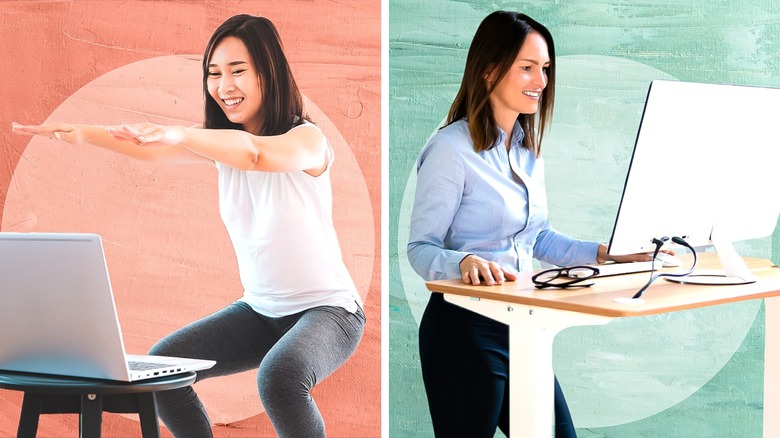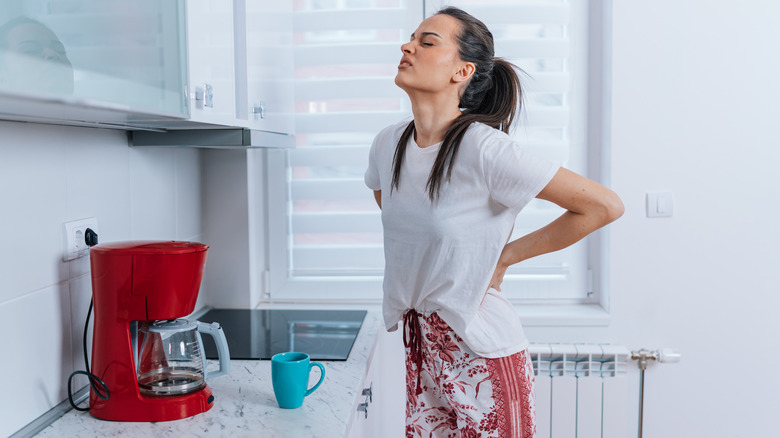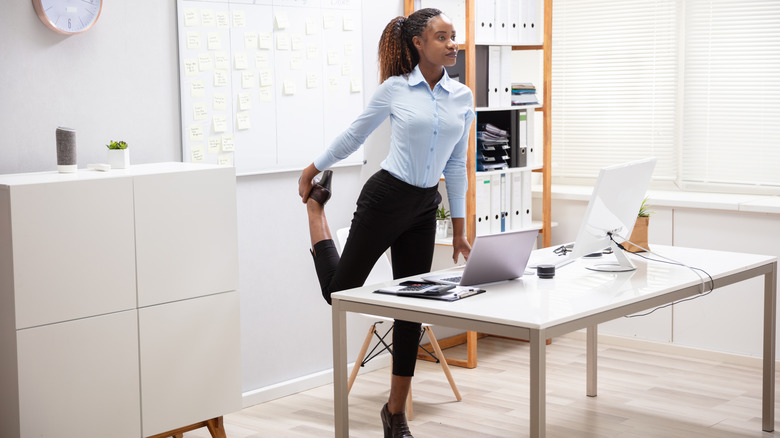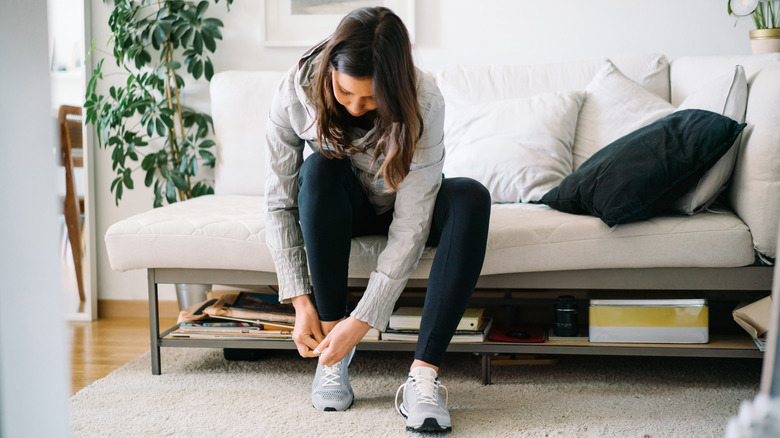Can Standing Be A Substitute For A Workout? Here's What To Know
By now, you've probably heard how bad sitting can be for your health. A sedentary lifestyle — think sitting at a desk all day or curling up on the sofa for hours at a time — has been linked to health issues such as heart disease, Type 2 diabetes, and cancer, according to the Centers for Disease Control and Prevention. With these issues in mind, many people have adopted standing desks in their offices and downloaded mobile apps that remind them to get up throughout the day.
Besides beating the downsides of excessive sitting, standing offers benefits of its own: A 2014 study published in the journal Occupational and Environmental Medicine found that people burned 174 more calories when standing for around three hours compared to sitting for the same period, which almost makes standing seem like a form of low-impact exercise.
But how does standing compare to a full-on workout? Can you swap your 50-minute gym sesh for a few hours of standing to stay in shape? Maybe not, say some experts. Cameron Yuen, certified strength and conditioning coach and physical therapist at Bespoke Treatments, told MyFitnessPal, "Standing desks can be helpful in mitigating some of the postural pains associated with sitting, but they are not a substitute for physical activity." Still, standing can — and should — be incorporated into your fitness routine in addition to your regular runs and barre classes.
What happens to your body when you stand?
As you might expect, when you stand up straight for a while, your body has to work harder compared to when you're lounging around in a chair or on your couch. "Standing for a long period of time can be physically demanding and may contribute to increased energy expenditure compared to sitting or sedentary activities," Heather Hamilton, ACSM certified exercise physiologist and co-founder of Barpath Fitness, shared with Well+Good. Moreover, standing activates the leg muscles, which are responsible for supporting the weight of your entire body, notes Cleveland Clinic.
Exerting energy and working your leg muscles might sound a lot like a workout, but simply standing differs from true exercise in some key ways. "Standing alone does not elevate your heart rate significantly, nor does it challenge your cardiovascular system in the same way that aerobic exercises like running, cycling, or swimming do," Hamilton told Well+Good. Put simply, yes, you're using your body in more ways than you would when hanging out in bed, but that doesn't place standing up in the same category as most other workouts.
Why you might feel sore after standing
So if standing isn't really a substitute for working out, why does it sometimes make you just as sore as an actual sweat sesh? According to the experts at London Bridge Orthopaedics, staying upright without the help of a chair or other crutch triggers muscle groups in the body to continuously contract. In other words, the muscles in your thighs, buttocks, calves, and other areas of the lower body are constantly moving — even if you don't really notice it happening — so that you don't lose balance and fall over.
The reason this can cause soreness over time is that those muscles don't get a break until you sit down or change your posture. Then, similar to what happens when you do several weight training reps or hold one challenging yoga pose, you may notice muscle fatigue and soreness.
Besides feeling sore in and around your legs, you might also spot discomfort in your lower back after spending time on your feet. As Medical News Today explains, this is often a sign that your back muscles are under stress. In some cases, this soreness is totally normal, especially if you're not used to standing much, and can be treated with basic rest. In other cases, back pain from standing could point to a condition such as spinal stenosis or degenerative disc disease.
How to make standing more like an actual workout
A standing position is the perfect starting point for some pretty simple exercises, and while they might not replace a full workout routine, these movements can still give your stationary pose a boost, whether you're waiting in line at the supermarket or parked behind your standing desk. "Standing alone can be enough, but you can always add in some exercise too, think lunges, calf raises, squats, dips on the chair, incline push-ups on the desk, or stretching, especially if you aren't working out outside of that," Sonya Robinson, a Chicago-based National Academy of Sports Medicine certified personal trainer and fitness nutrition specialist, explained to Fortune. "Always start with a shorter duration, such as 15 minutes per hour, and build up from there."
If you're unable to move much from your standing position, try stretches instead. Reach down and touch your toes to stretch your legs, lift your heel and grab your ankle to target your quadriceps, or clasp your hands and extend up to work the arms. Simple stretches like these can improve flexibility, increase blood flow, and boost muscle functioning, as per the Mayo Clinic.
The real risks of standing too much
If you can overcome the potential soreness associated with standing, it might seem like an ideal, low-impact alternative to sitting, but standing too much can pose health risks of its own. "It's not great to stand the entire day," physical therapist Karena Wu revealed to Insider. "Standing too long creates too much general joint compression. You need to have breaks and sit to give the body a break." Not only that, but you might suffer some of the same issues thought to be caused by sitting too much.
One 2015 research article published in Rehabilitation Nursing Journal found that people who are required to stand for long periods at work experience more pain, fatigue, pregnancy complications, and cardiovascular ailments. A 2017 study published in the American Journal of Epidemiology even discovered that people who had jobs where standing was the norm were twice as likely to develop heart disease as those who mostly sat down at work.
Standing too much can also cause varicose veins, according to Johns Hopkins Medicine. When you stand in one place too long, blood collects in the veins in the legs, causing them to stretch and weaken. Though rare, varicose veins can sometimes trigger the development of blood clots.
When to stand and when to get moving
Clearly, there's a time and place for both standing and working out (and, of course, sitting to watch your favorite comfort shows and movies — you earned it), but how much time should you spend doing each? Spoiler: There's no one-size-fits-all answer, and your mobility level and personal health conditions can play a major role. As a rule of thumb, the U.S. Department of Health and Human Services encourages adults to aim for 150 to 300 minutes a week of moderate-intensity activity or 75 to 150 minutes a week of vigorous-intensity activity.
Outside these guidelines, standing can help break up a sedentary routine, though it's best not to overdo it (remember the risk of heart disease and varicose veins we talked about). A 2015 consensus statement published in the British Journal of Sports Medicine argued that individuals who spend most of their workdays sitting should incorporate between two and four hours of standing and light activity (such as light walking) into each day. Even if you don't spend all day behind a desk or seated in an office, standing can be a good option when tending to an easygoing task, like making a phone call or messaging a friend. In these cases, consider swapping your chair for your feet.
Stay comfy while standing
Just like during a regular workout, it's crucial to maintain good form to avoid injuries or discomfort when standing. "The way we stand is so important. Our body can only handle so much strain in one position," Dr. Diane Koshimune, a podiatrist, shared with The New York Times. Dr. Koshimune suggested avoiding a relaxed stance where the feet roll inward and instead adopting an "active" stance with the leg muscles engaged and the kneecaps rotated slightly outward. "Mindfulness can help to make standing a little more comfortable," she added.
A good pair of shoes can also support your feet and legs, helping to stave off soreness. University of Michigan's University Health Service suggests skipping the painful flip-flops and opting for sturdy shoes with arch support, a stiff back, and a flexible toe area.
Finally, as further evidence that standing alone can't replace working out, muscle-strengthening exercises can actually help make standing more bearable. Rob Thorburn, a physiotherapist, told ABC Everyday that weight training, pilates, and walking train your legs to endure prolonged standing, especially if you're not used to being on your feet.






